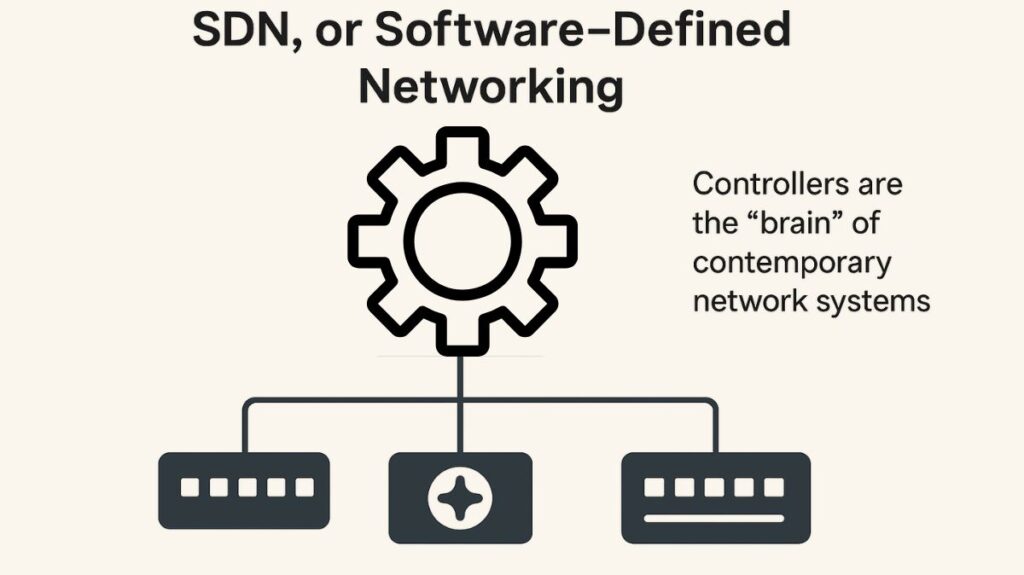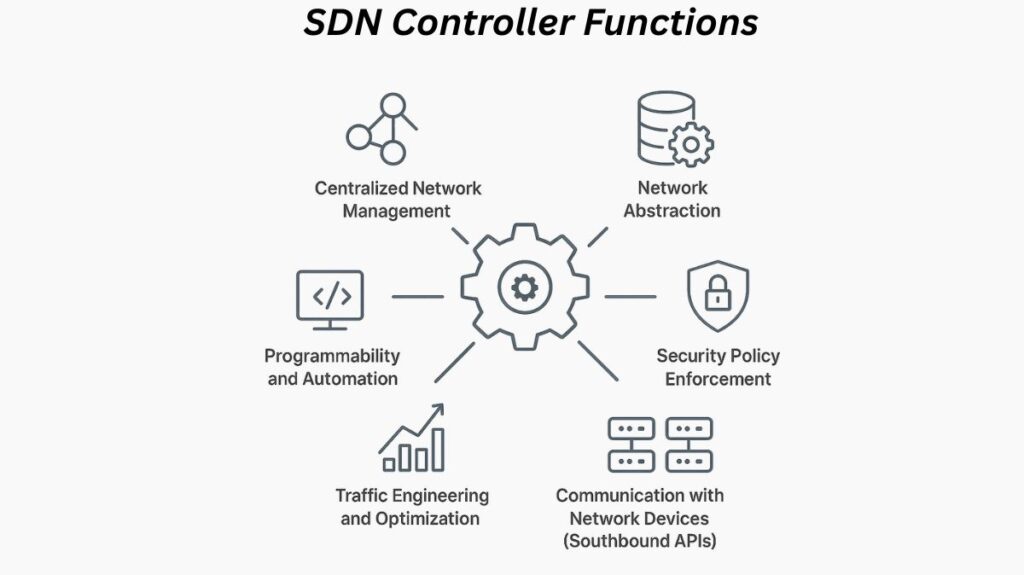This article gives an overview of SDN Controllers, Architecture, Examples, SDN Controller Functions, Advantages and Disadvantages.
SDN Controllers
SDN, or Software-Defined Networking (SDN), controllers are central management software that act as the “brain” of contemporary network systems. In contrast to conventional, distributed approaches, they play a vital role in centralizing control over networking equipment, allowing for a more effective, programmable, and automated approach to network management.

SDN Controller Architecture
Centralized Control Plane: In conventional networks, every device (such as a switch or router) controls its own control plane. In contrast, SDN controllers aggregate these control plane operations into a single application, allowing network devices to concentrate mostly on data plane activities. In order for the data plane to make forwarding decisions, the control plane must create and maintain data such as MAC address tables and routing tables. In essence, the SDN controller serves as the network’s operating system.
Decoupling Control and Data Planes: The division of the data plane, which handles the actual forwarding of data or packets, from the control plane, which decides how traffic should flow, is a key component of SDN. The control plane is where the SDN controller is located.
Management Plane: This plane does not directly affect data forwarding; instead, it manages network device management activities (such as CLI, Telnet, SSH, SNMP, and Syslog).
Three-Layer Architecture: The Infrastructure Layer (physical switches and network devices), the Control Layer (which houses the SDN controller), and the Application Layer.
Key Interfaces
Through particular interfaces, SDN controllers can interact with different components of the network architecture:
Southbound Interface (SBI):
Communication between the SDN controller and the underlying network devices such as switches and routers is made easier by this interface. The controller may program these devices’ data plane forwarding tables thanks to SBIs. Here are some instances of SBIs:
- OpenFlow: A standard method for managing traffic flows and switching capabilities is defined by an IP-based protocol that is utilized between the controller and network devices.
- OpFlex: A proprietary southbound protocol from Cisco that is utilized with Cisco Application Centric Infrastructure (ACI).
- CLI (Telnet/SSH) and SNMP: Cisco Software-Defined Access and Cisco APIC-EM are two examples of controllers that use it to manage network devices that are already in place.
- NETCONF and RESTCONF: Cisco DNA Centre and other more recent controllers and devices support it.
Northbound Interface (NBI):
Applications can interact with the SDN controller through this interface, utilizing its data and features for network programmability. It gives applications the ability to use APIs (Application Programming Interfaces) to program flows into devices using SBIs and get data from the controller. JSON (JavaScript Object Notation) and other data formats are frequently used in this.
SDN Controller Functions

In software-defined networks, an SDN controller serves as the “brain” at its core. By separating the data plane the actual hardware that transfers traffic from the control plane, or the network’s intelligence, network managers may oversee the whole system from a single, central place.
Centralized Network Management:
The primary purpose of an SDN controller is this. For monitoring, controlling, and enforcing policies throughout the network, the controller offers a single dashboard, eliminating the need to manually configure every single network device (such as a router or switch). This lowers the possibility of human mistake, streamlines network administration, and saves time.
Network Abstraction:
The controller generates a consistent, abstract representation of the physical infrastructure that underpins the network. This makes it possible for applications and network managers to communicate with the network as a single logical unit without having to be familiar with the unique setups or particulars of every single device.
Programmability and Automation:
Making the network programmable is one of the main roles of the SDN controller. It provides interfaces (Northbound APIs) that let other apps manage the network programmatically. Thus, it is possible to:
- Dynamic Configuration: Real-time, autonomous network adjustments can be made to accommodate fluctuating traffic needs.
- Automation of Tasks: Automating routine processes like as device provisioning, traffic management, and security policy enforcement is possible.
- Rapid Innovation: In order to promote creativity and agility, developers can design unique apps and services that communicate with the network directly.
Traffic Engineering and Optimization:
The SDN controller can make wise choices regarding data traffic routing by having a global, real-time view of the whole network. It can prioritize important applications, balance network loads, and optimize packet pathways to lessen congestion and boost overall network effectiveness.
Security Policy Enforcement:
Security is made simpler by the SDN controller’s centralized architecture. It allows set uniform security rules for the whole network from a single location. This enables:
- Micro-segmentation: Potential dangers can be contained by the controller by establishing separated network segments.
- Centralized Monitoring: By giving a thorough picture of network traffic, it facilitates quicker threat identification and mitigation.
- Automated Response: In reaction to an identified security danger, such as the quarantining of a compromised device, the controller can be configured to automatically modify network parameters.
Communication with Network Devices (Southbound APIs):
Standardized protocols (Southbound APIs, such OpenFlow) are used by the controller to connect with the switches and routers that make up the underlying network. Each device’s data plane receives precise instructions on how to forward, drop, or alter packets based on the high-level policy choices made in the control plane.
SDN Controller Benefits
Among the many benefits that SDN controllers provide are:
Centralized Management and Automation: Setting up network features instead of individual devices enables network engineers to manage and setup big networks faster, more reliably, and frequently with fewer mistakes. By enabling networks to automatically find and setup switches and fabrics, this also streamlines operations.
Network Programmability: By enabling applications to autonomously create and run networks via robust APIs, controllers promote a DevOps methodology and enable customization of network behaviour.
Consistent Configuration: Centralizing control allows controllers to guarantee that device configurations are uniform throughout the network.
Reduced Project Time and Faster Troubleshooting: Reduced project completion times and simpler troubleshooting are the results of automation and centralized operational data collecting, which also yield actionable insights through predictive insights, machine learning, and data analytics.
New Operational Models: Intent-based networking (IBN), where the engineer specifies the intended result and the controller ascertains the required configurations, is one of the novel models made possible by controllers.
Network Virtualization: Because they make it possible to build virtual networks on top of physical infrastructure, cloud applications can benefit greatly from variable resource allocation and isolation.
Robust Security: A more comprehensive picture of security vulnerabilities is provided by SDN controllers, which enable insight throughout the entire network. Operators have the option to quickly isolate compromised devices or create distinct zones for devices with varying security levels.
Improved Agility and Flexibility: SDN controllers provide for quicker network deployments and modifications, responding to changing traffic demands and business requirements.
Reduced Operational Costs: SDN controller automation lowers the need for human configuration and troubleshooting, which saves money and makes it possible to employ less expensive off-the-shelf hardware.
Enhanced Network Performance: By lowering latency and dynamically modifying resource allocation and traffic patterns, they can maximise network performance.
Converged Management: The ability to administer wired and wireless LANs from a single platform, such as Cisco DNA Centre, makes activities like deploying QoS settings easier.
How SDN Controller Works

Examples of SDN Controllers
There are numerous open-source and proprietary SDN controller options available, including:
- Cisco DNA Center: Software-Defined Access (SDA) solution from Cisco’s main enterprise SDN controller and network management platform. Telnet, SSH, SNMP, NETCONF, RESTCONF, and other southbound APIs are supported, and it controls both conventional and SDA-enabled network devices.
- Cisco APIC Enterprise Module (APIC-EM): For businesses, an earlier Cisco SDN solution that uses well-known SBIs like SNMP and CLI (Telnet/SSH) to manage current network devices. Through the management plane, it indirectly affects data and control planes rather than directly programming them. A lot of its features are now part of Cisco DNA Centre.
- Cisco Application Centric Infrastructure (ACI): Using the idea of endpoint groups and rules, Cisco’s SDN solution for data centers uses OpFlex as its southbound protocol.
- OpenDaylight Controller: The OpenFlow protocol serves as the SBI for this open-source SDN controller, which centralizes the majority of control plane operations.
- ONOS (Open Network Operating System): Campus and service provider networks frequently use this additional open-source choice.
- VMware NSX: A network virtualisation and security platform with a controller for virtual network environment management.
- Wireless LAN Controllers (WLCs): An illustration of a wireless access point management system based on controllers.
- Other suppliers of SDN controllers include Nvidia, Pica8, NEC Corporation, Hewlett Packard Enterprise, Juniper Networks, and Nuage Networks. Other open-source choices are Tungsten Fabric, NOX, and POX.
SDN Controller disadvantages
SDN controllers have many advantages, however there is also a chance of danger:
- Because the controller is centralized, it could be a single point of failure. The entire network might be impacted if the controller is compromised or goes down.
- Maintaining a secure network requires protecting the controller since anyone controls it has access to the entire network.
- Although it may cost more, enabling controller redundancy (e.g., employing numerous controllers with automatic failover) might alleviate this problem.
